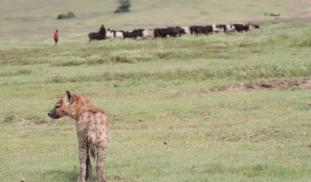Please wait...
About This Project
Spotted hyenas are successful carnivores that show the ability to survive in human-dominated areas. However, they can be implicated in human-wildlife conflict via livestock depredation. We will use DNA metabarcoding to assess how hyenas in the Ngorongoro Conservation Area respond to a major increase in livestock abundance. The findings will help promote balanced conservation outcomes for both people and wildlife and improve our understanding of hyena behavioral flexibility.
More Lab Notes From This Project

Browse Other Projects on Experiment
Related Projects
How do polar bears stay healthy on the world's worst diet?
Polar bears survive almost entirely on seal fat. Yet unlike humans who eat high-fat diets, polar bears never...
Uncovering hidden insect diversity associated with a likely undescribed gall-forming midge
Does a likely undescribed species of gall-forming midge (pers. comm. Ray Gagné) on Eriodictyon plants (Yerba...
Macrofungi of the California archipelago
The eight islands of the California Archipelago are a well-studied biodiversity hotspot — but we know almost...





